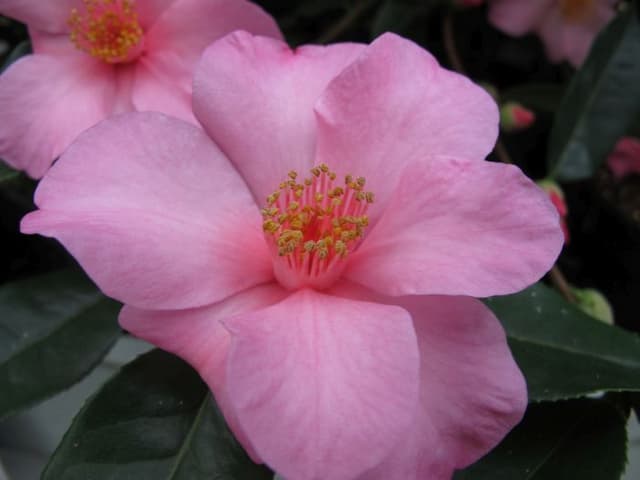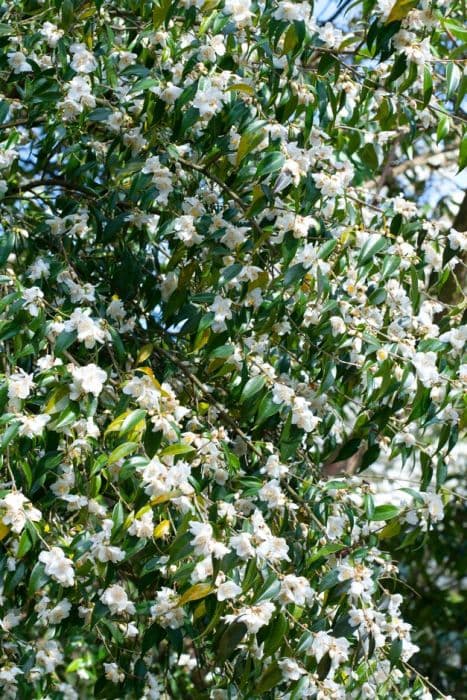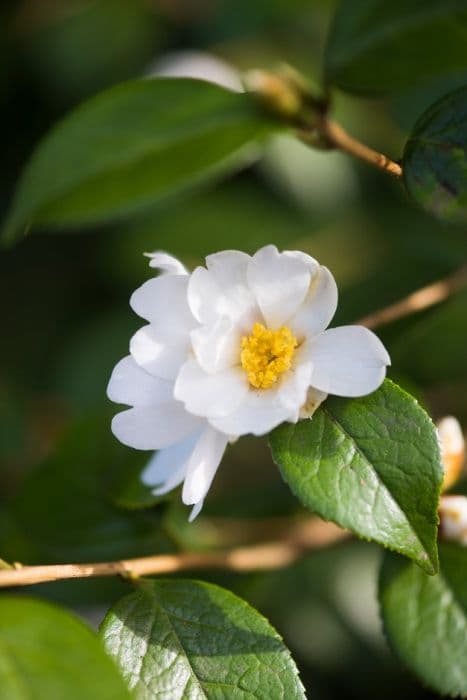Japanese Camellia Camellia japonica 'Wilamina'

ABOUT
Camellia japonica 'Wilamina' is an ornamental shrub known for its striking blooms and glossy green foliage. Its flowers are particularly showy, often a deep pink or rose color, with a formal double flower form—this means that the blooms have several layers of petals that are neatly arranged in a symmetrical fashion. The petals are typically rounded, contributing to the flower's full and lush appearance. The blooms stand out against the plant's backdrop of shiny, dark green leaves, which are oval-shaped and have a leathery texture. The contrast between the vibrant flowers and the rich foliage makes 'Wilamina' a highly desirable variety for gardens and landscapes where it can serve as a focal point during its blooming season.
About this plant
 Names
NamesFamily
Theaceae.
Synonyms
Japanese Camellia, Rose Of Winter, Japonica.
Common names
Camellia japonica 'Wilamina'.
 Toxicity
ToxicityTo humans
Camellia, the most common name for Camellia japonica 'Wilamina', is not considered toxic to humans. Generally, if ingested, it does not cause poisoning or adverse symptoms. Therefore, there are no specific toxicity consequences associated with the ingestion of any parts of this plant to humans.
To pets
Camellia, the most common name for Camellia japonica 'Wilamina', is also not considered toxic to pets. It is generally safe, and ingestion is unlikely to lead to poisoning or serious symptoms in animals such as dogs or cats. There are no well-documented toxicity concerns or consequences associated with pets ingesting parts of this plant.
 Characteristics
CharacteristicsLife cycle
Perennials
Foliage type
Evergreen
Color of leaves
Dark green
Flower color
Pink
Height
6-10 feet [1.8-3 meters]
Spread
5-7 feet [1.5-2.1 meters]
Plant type
Shrub
Hardiness zones
7
Native area
Japan
Benefits
 General Benefits
General Benefits- Ornamental Value: Camellia japonica 'Wilamina' is highly regarded for its beautiful, large, rose-pink flowers that add aesthetic appeal to gardens.
- Long Blooming Season: This plant typically flowers from late winter through spring, providing color during a time when many other plants are dormant.
- Evergreen Foliage: As an evergreen shrub, it maintains its glossy, dark green leaves throughout the year, contributing to the garden's permanence and structure.
- Shade Tolerance: It is capable of thriving in partially shaded areas where other flowering plants may not perform well.
- Drought Resistance: Once established, Camellia japonica 'Wilamina' can tolerate periods of dryness, making it suitable for gardens with less frequent watering.
- Versatility: Suitable for use in a variety of landscape designs including borders, foundations, and as specimen or accent plants.
- Privacy Screening: With its dense growth habit, it can be used as a privacy hedge or screen, providing seclusion and noise reduction.
- Wildlife Attraction: The flowers can attract pollinators such as bees, while the dense foliage provides shelter for birds.
- Low Maintenance: It generally requires minimal pruning and care once established, making it a convenient choice for gardeners of all skill levels.
- Cultivar Variety: 'Wilamina' is one of many cultivars, offering gardeners the opportunity to select a plant that matches their specific landscape needs and preferences.
 Medical Properties
Medical PropertiesThis plant is not used for medical purposes.
 Air-purifying Qualities
Air-purifying QualitiesThis plant is not specifically known for air purifying qualities.
 Other Uses
Other Uses- Camellia japonica 'Wilamina' petals can be crystallized and used as edible decorations for cakes and desserts, giving them an elegant and natural touch.
- The thick, glossy leaves of the camellia can be used in floral arrangements and wreath bases to provide rich green backdrops that enhance the appearance of other flowers.
- Dried camellia petals can be incorporated into homemade potpourri mixes, adding a touch of color and a faint pleasing scent to a room.
- Cold-pressed oil from camellia seeds, sometimes used in various crafting endeavors, can be applied as a protective finish to woodwork or leather goods.
- Pressed flowers and leaves of the camellia plant can be used in artistic crafts, such as creating unique botanical paper or artwork for home décor.
- The petals of Camellia japonica can be used as a natural dye for fabrics, offering hues ranging from light pink to a deeper reddish color depending on the concentration.
- The plant itself can be shaped through the art of bonsai, with the camellia's naturally small leaves making it a suitable candidate for miniature tree sculpting.
- Camellia wood, known for its density and smooth grain, can be carved into small objects such as buttons, jewelry, or intricate charms.
- The thick foliage of the camellia plant can offer shelter and nesting opportunities for small birds and beneficial insects when grown in a garden.
- Used in companion planting, camellias can provide shade and wind protection for more delicate plants that require such conditions to thrive.
Interesting Facts
 Feng Shui
Feng ShuiThe Camellia is not used in Feng Shui practice.
 Zodiac Sign Compitability
Zodiac Sign CompitabilityThe Camellia is not used in astrology practice.
 Plant Symbolism
Plant Symbolism- Adoration: Camellia japonica is often associated with deep admiration and devotion, making it a perfect symbol to express genuine fondness towards someone.
- Perfection: Frequently representing the ideal or perfection, this plant is a symbol for something unimpeachably beautiful and flawless.
- Longevity and Gratitude: The Camellia's enduring nature conveys long-lasting life and gratitude, often given as a gift to show appreciation for someone’s contribution to another's life.
- Love: Different colors of camellias symbolize various aspects of love. The Camellia japonica, with its extravagant and elegant blooms, can signify the deep romantic or platonic love one person holds for another.
- Refinement: With its lush petals and sophisticated appearance, the camellia is also a metaphor for refined beauty and polished elegance.
 Water
WaterJapanese camellia 'Wilamina' should be watered to keep the soil consistently moist but not soggy. During the growing season, water with approximately 1-1.5 gallons per week, but adjust based on rainfall and temperatures. In winter, reduce watering to when the top inch of soil feels dry. Over-watering or allowing the roots to sit in water can lead to root rot, so ensure good drainage. Water at the base of the plant to avoid wetting the foliage, as this can lead to fungal diseases.
 Light
LightJapanese camellia 'Wilamina' prefers bright, filtered light with protection from harsh afternoon sun. A spot that receives morning sun with partial shade in the afternoon is ideal. Avoid exposing the plant to full sun in hot climates as this can cause leaf scorch.
 Temperature
TemperatureJapanese camellia 'Wilamina' thrives in temperatures between 60 and 80 degrees Fahrenheit. It can tolerate minimum temperatures down to 20 degrees Fahrenheit but cold temperatures can damage the buds and flowers. Protect from frost and extreme heat for best results.
 Pruning
PruningPrune Japanese camellia 'Wilamina' as needed to shape the plant or to remove dead or damaged branches. The best time for pruning is just after blooming ends, but before the new buds for the next season set. Pruning too late can result in the loss of next year's flowers. Do not prune excessively, as camellias are slow to recover from heavy cutting.
 Cleaning
CleaningAs needed
 Soil
SoilThe Japanese Camellia 'Wilamina' prefers well-draining, acidic soil with a pH of 5.5 to 6.5. A good mix can be made with 50% peat moss or compost, 30% pine bark, and 20% perlite or sand to ensure proper drainage and maintain acidity.
 Repotting
RepottingJapanese Camellias 'Wilamina' should be repotted every 2-3 years, during spring before the growing season starts. Younger plants may need repotting annually if they outgrow their pots rapidly.
 Humidity & Misting
Humidity & MistingJapanese Camellia 'Wilamina' thrives best in moderate to high humidity levels, ideally around 40-60%. They appreciate a humid environment but can tolerate lower humidity levels with proper care.
 Suitable locations
Suitable locationsIndoor
Ensure bright, indirect light and high humidity.
Outdoor
Plant in partial shade with shelter from strong winds.
Hardiness zone
7-9 USDA
 Life cycle
Life cycleCamellia japonica 'Wilamina', commonly known as Japanese Camellia, begins its life as a seed, which when conditions are right, germinates and develops a root system and a shoot that grows toward the light. The seedling stage involves the formation of basic plant structures and progresses as the plant develops true leaves and gains the ability to photosynthesize more effectively. As it enters the vegetative stage, the Japanese Camellia focuses on growth, producing stems, leaves, and a stronger root system, preparing for eventual blooming. The flowering stage typically occurs in late winter to early spring, with 'Wilamina' showcasing ornate, pink to deep red flowers that attract pollinators, although the plant is also capable of self-pollination. After pollination, the plant produces fruit in the form of dry capsules containing seeds, which upon reaching maturity, are dispersed to start a new life cycle. The Japanese Camellia is an evergreen perennial, meaning that it will go through multiple flowering cycles while maintaining its leaves throughout the year, potentially living for many decades with proper care.
 Propogation
PropogationPropogation time
Spring-Early Summer
Propogation: The Camellia japonica 'Wilamina', commonly known as the Japanese camellia, is most effectively propagated through semi-hardwood cuttings. This method is popular due to its relative ease and effectiveness for home gardeners and professionals alike. The ideal time to take cuttings is in late summer, once the current season's growth has begun to mature. Cuttings should be about 4 to 6 inches (10 to 15 centimeters) long, with several leaves left at the top. The lower leaves are removed, and the cut end of the stem is often dipped in a rooting hormone to encourage root development. The prepared cutting is then inserted into a pot filled with a well-draining potting mix or a mix specifically designed for cuttings, ensuring the leaf nodes are beneath the soil surface. The pot should be kept in a warm place with indirect light, maintaining moisture without being waterlogged, until roots have developed sufficiently to allow transplanting, which typically takes several months.









